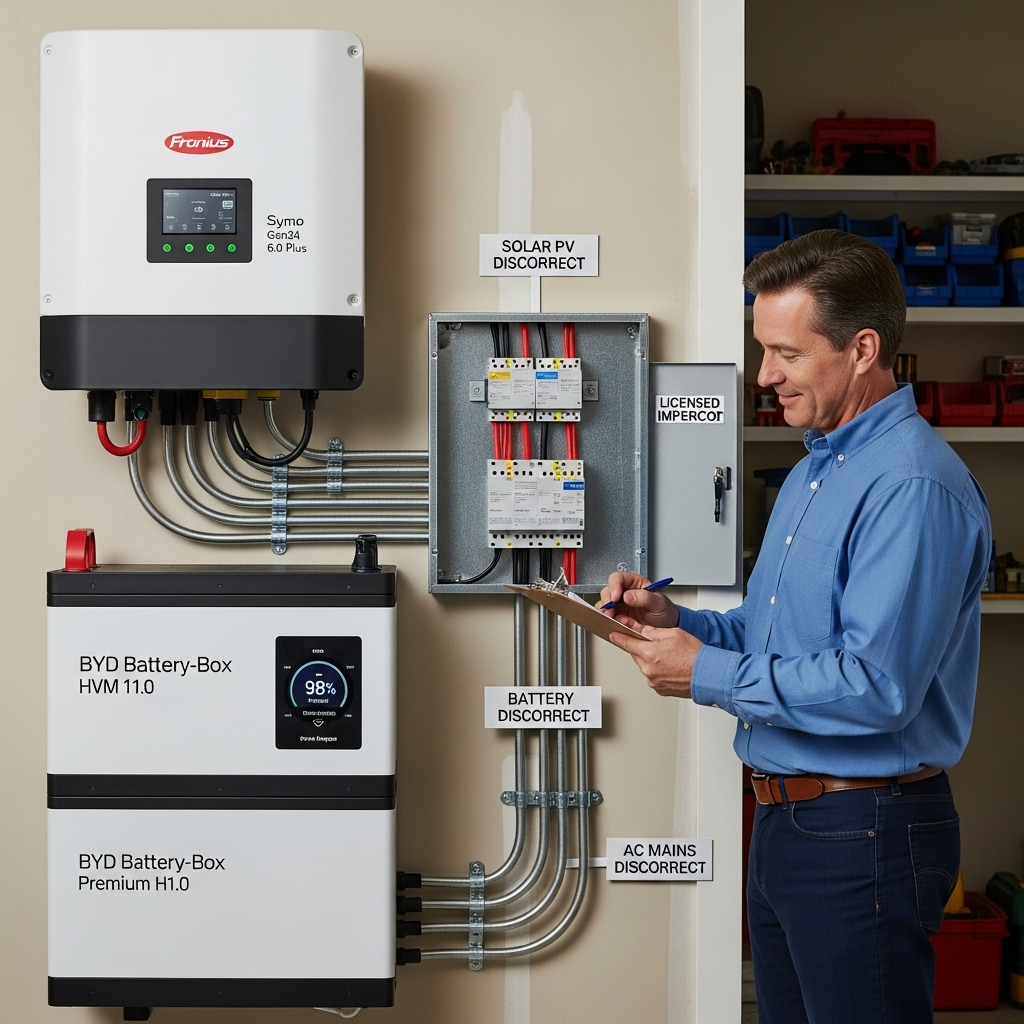Proper labeling on a solar or energy storage system is more than just a final touch; it's a critical component for safety and regulatory approval. For installers, getting the signage right the first time prevents costly delays and ensures the system is safe for homeowners, maintenance crews, and emergency responders. The National Electrical Code (NEC) provides the definitive standards, specifically in Article 690 for Photovoltaic (PV) Systems and Article 706 for Energy Storage Systems (ESS). This guide offers clear, practical steps to achieve NEC signage compliance.
The Foundation of PV System Labeling: Understanding NEC Article 690
NEC Article 690 is the cornerstone of PV system safety and installation standards. It covers everything from wiring to overcurrent protection, but its signage requirements are among the most visible and frequently inspected elements. Getting these labels correct is a primary step toward a successful project completion.
Core Requirements of NEC 690.56
One of the most critical labels specified in the code is for the rapid shutdown system. NEC 690.56 mandates clear identification for the Photovoltaic System Rapid Shutdown (PVRSS) initiator. This label is vital for firefighters, allowing them to quickly de-energize the solar array on the roof in an emergency. The requirements are precise: the label must feature the words 'RAPID SHUTDOWN' in white letters on a red background. It must be placed within 3 feet of the initiation device and be clearly visible.
Key Signage Beyond Rapid Shutdown
Beyond the PVRSS, PV 690 details several other essential solar panel labeling requirements. All DC disconnects must be clearly marked to indicate they control a photovoltaic power source. You will need labels identifying the system's operating voltage and current to inform service personnel of the electrical characteristics. A common and required label at the main service panel warns of multiple power sources, such as 'WARNING: DUAL POWER SOURCE'. All these markers must be made of a durable material suitable for the environment, ensuring they remain legible for the system's entire lifespan.

Navigating Energy Storage Systems: NEC Article 706 Signage
As energy storage becomes more common, so do the regulations governing it. NEC Article 706 was developed to address the unique safety considerations of ESS. Proper NEC 706 signage is essential for anyone interacting with the system, from the owner to first responders.
Identifying the ESS: Core Labeling Mandates
The primary goal of ES 706 NEC signage is identification. A master placard at the main service panel must indicate the presence of an on-site ESS. This placard should detail the location of the storage system and provide a clear, concise shutdown procedure. This procedure is arguably the most important piece of information, as it guides emergency personnel in safely isolating the battery. The type of battery technology, such as LiFePO4 (Lithium Iron Phosphate), should also be identified, as different chemistries can have different handling requirements.
Specific Signage for ESS Disconnects and Components
Every disconnect switch associated with the ESS must be clearly labeled as 'ESS DISCONNECT'. This prevents accidental energization during maintenance. If the system includes a hybrid inverter that manages both solar and storage, its labeling must reflect its dual function. The growth in clean energy technologies, as noted in the IEA's Energy Technology Perspectives 2024, makes standardized safety protocols like these increasingly important. The following table contrasts the basic labeling needs for different system types.
| Feature | PV System (NEC 690) | Energy Storage System (NEC 706) | Combined System |
|---|---|---|---|
| Primary Article | NEC Article 690 | NEC Article 706 | Both Articles Apply |
| Rapid Shutdown | Required (690.56) | Part of the overall system design | PVRSS label required |
| System ID | 'PHOTOVOLTAIC POWER SOURCE' | 'ENERGY STORAGE SYSTEM' | Both may be required |
| Disconnects | Labeled as 'PV SYSTEM DISCONNECT' | Labeled as 'ESS DISCONNECT' | All disconnects clearly identified |
| Shutdown Procedure | Simple disconnect procedure | Must include detailed shutdown sequence | Comprehensive shutdown procedure for both |
Best Practices for Creating Durable and Compliant Labels
Creating labels that meet NEC standards involves more than just correct text. The physical characteristics of the labels are just as important to ensure they last and communicate effectively over the long term.
Material and Durability Matters
The NEC requires that labels be 'of sufficient durability to withstand the environment involved'. This effectively prohibits the use of handwritten markers or simple paper labels. The industry standard is engraved phenolic placards or high-performance, UV-resistant vinyl labels. These materials resist fading from sunlight and degradation from weather, ensuring the safety information remains clear and legible for decades.
Clarity, Contrast, and Placement
For a label to be effective, it must be easily read. Use high-contrast color schemes, such as white text on a red background for warnings or black text on a white background for information. The font size should be large enough to be read from a reasonable distance. Proper placement is also key; labels should be affixed directly to the equipment they describe or immediately adjacent to it. A disconnect label placed ten feet away from the switch is not compliant or helpful.
Integrating Performance Data with Safety Labeling
While NEC signage compliance focuses on safety, understanding system performance is equally important for the system owner. Clear safety placards and performance documentation can coexist to create a fully transparent and user-friendly system. While safety labels warn of hazards, a separate system information placard can provide valuable data like nominal power output, storage capacity, and expected production. For a deeper look into evaluating the efficiency of your setup, a comprehensive guide on solar storage performance can provide valuable metrics and benchmarks. This approach combines the mandated safety information with practical operational data.
A Proactive Approach to Compliance
Achieving full compliance with NEC 690.56 and NEC 706 signage is a matter of diligence. The rules are designed to protect everyone who interacts with a solar and storage system. By using durable materials, clear text, and correct placement, you ensure your installations are not only efficient but also fundamentally safe. Always consult the latest NEC version adopted by the local Authority Having Jurisdiction (AHJ), as codes are updated periodically. A proactive and thorough approach to labeling demonstrates professionalism and a commitment to safety that defines high-quality energy solutions.
Frequently Asked Questions
What happens if my solar panel labels are not compliant?
Non-compliant labels can lead to a failed inspection, causing project delays and additional costs for re-labeling and re-inspection. More importantly, it can create a safety hazard for emergency responders and maintenance personnel who rely on accurate information to work safely.
Do I need different labels for an off-grid solar system?
Yes, while many core principles apply, off-grid systems have unique labeling requirements. You must clearly identify the system as a standalone power source and label all disconnects and power-generating equipment accordingly. The specific requirements can vary, so always check the current NEC and local codes.
Where can I find the exact wording required by the NEC?
The National Electrical Code itself is the primary source. Sections like 690.13, 690.31, 690.56, and the entirety of Article 706 provide the specific text, size, and color requirements. Many professional label suppliers also offer pre-made, compliant labels based on the latest code cycle.
How often does the NEC update its solar panel labeling requirements?
The NEC is updated every three years. It is important for installers and system designers to work with the code cycle adopted by their local jurisdiction, as there can be a lag between a new NEC release and local adoption. Significant changes to labeling are often introduced with new cycles.





Leave a comment
All comments are moderated before being published.
This site is protected by hCaptcha and the hCaptcha Privacy Policy and Terms of Service apply.